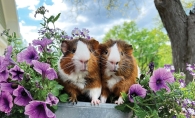Nature can be like an outdoor canvas—ephemeral scenes of seasonal splendor. Some views develop organically, created by wind, rain and sun. Gardeners and landscape designers create other scenes, like artists who shape sculptures from soil, shrubs, and seeds. But it’s landscape photographers who capture those scenes and create another dimension of beauty that can be preserved, printed, displayed and enjoyed again and again.
Meet Chip Jones and Steve Silverman, two Edina photographers who’ve managed to take landscape photography to the next level. Their creations of fine art and commercial landscape photography will dazzle and draw you in to scenes that look a bit like paradise.
Chip Jones
Chip Jones was a junior in high school when he bought his first Minolta XG-1 from Dayton’s at Southdale Center. Drawing and painting were his artistic passions at that time, but he also enjoyed taking landscape photos while traveling, hiking or canoeing. While pursuing a liberal arts degree in college, Jones took a photography class and began to discover his artistic talent as a photographer. He went on to graduate with a bachelor of fine arts degree from the University of Minnesota. Still unconvinced that photography would be his future, Jones applied to and was accepted at the prestigious California Institute of Arts to study animation and film.
“I had a great time at CalArts,” says Jones. “But I found out that I’m not a great film-maker. It’s a whole different creative process.”
A career in advertising and a bride from Edina would draw Jones back to Minnesota, where he now spends a majority of his time outdoors scouting locations and shooting landscape photography for both fine art and commercial use. “It’s a great time to be a photographer,” Jones says, adding that old-timers may disagree since the field has been taken over by digital artists. “Working in a darkroom was a challenging environment,” says Jones. “Now, I can make photos without putting my hands in chemicals and I’m able to see the work right away.”
Jones’ process involves surveying a location for several hours or days while deciding on his subject matter. A typical day for Jones might involve four hours of shooting approximately 400 shots. Then he goes home to download and review his work. “I get down to around 40 [photographs] that I really like and delete the rest.” He prefers to keep colors fairly accurate, not heavily enhancing his work. He will also crop and tighten images until he finally arrives at five to 10 finished pieces of artwork that can either be displayed as fine art prints for residential or commercial interiors or sold as commercial photos for use in print and online media. One of Jones’ favorite photographs is of Centennial Lakes just before sunrise. It has a beautiful blue cast and melted ice on the lake. He says, “It’s a still, calm photo that I think is one of my best.”

Steve Silverman
While Steve Silverman was in college at the University of Pennsylvania, a friend dragged him to New York City to purchase his first camera. “He must have had a sense that I needed to explore my creative side,” Silverman says. He then admits that once those first prints came out of the bath in the darkroom, he was hooked. Silverman would go on to become an accountant and a self-taught photojournalist, as well as managing a family clothing business in Grand Forks, North Dakota.
His home state would inspire Silverman’s interest in landscape photography. He took a picture at sunset of Kelly’s Slough, a national wildlife refuge located between Larimore and Grand Forks in North Dakota, and thought he might be on to something. “North Dakota is not as flat and uninteresting as people think,” Silverman says. So he embarked on a multi-year project to purposefully find and photograph beautiful places in North Dakota. The result is a hardcover coffee-table book, America’s Land of Tranquility: Visions of the Secret Beauty of North Dakota, co-authored by his wife, Robin.
Along the way, an architect friend of Silverman’s suggested he try architectural and commercial landscape photography, and a business has burgeoned as a result. Then “our kids grew up and our dog died. So my wife and I decided to move from Grand Forks to the Twin Cities,” says Silverman, who was practically commuting to the metro area for his growing photography business. (He also shoots many business portraits of employees of metro companies in his Edina studio.)
For Silverman, a photo shoot for a commercial landscape project typically begins with a consultation with the landscape designer and doing some pre-shots before and during construction. Silverman believes it’s also important to meet the homeowners, because when a homeowner can articulate what makes an outdoor space special, Silverman can orient his shots to illustrate that theme. For example, if an outdoor space is being designed specifically to promote family togetherness, Silverman aims to tell that story through his photography.
Many of Silverman’s photographs are created by stacking layers of as many as 36 or 48 separate images. Some are used for their bright highlights, others for shadows. And still others provide focus on foreground and background. Selected images are brought together in post-processing to create a single breathtaking image. “Opportunities to create images of a great project is a juicy experience,” says Silverman. “It makes you feel wonderful.”











